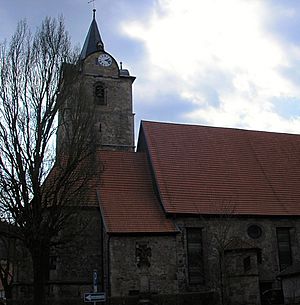St. Bartholomew's Church, Themar facts for kids
St. Bartholomew's Church is a special church in the town of Themar, Thuringia. It is named after St. Bartholomew. This church is one of the most beautiful and well-decorated churches in the upper Werra valley. It's also one of the few old buildings in Themar that has survived for a very long time. The town of Themar was first mentioned way back in 796!
Long ago, there were two first churches in Themar. One was called the Oberkirche (upper church) and the other was the Unterkirche (lower church). Today, you can still see parts of the old Romanesque Unterkirche in the church's vestry and the lower parts of the church tower.
In 1484, Pope Sixtus IV gave permission to fix up the church. This happened thanks to Countess Margaretha of Henneberg. Then, in 1488, a church leader named Antonius König started building the church we see today. The main part of the church, built in a style called Late Gothic, was finished in 1502.
The Protestant Reformation came to Themar in 1544. After this, the church received many smaller carved altars from other churches. Over the next few decades, starting in 1541, the church building was changed and updated many times.
Inside, a curved ceiling called a barrel vault was added. Two special balconies, called matroneums, were also put in. The wooden beams supporting these balconies have cool sculptures of faces on them. You can find similar face sculptures in churches in Rohr and Herpf, near Meiningen.
The matroneums also have sculptures of saints and apostles on their columns. Some of these came from older Gothic altars. They are also decorated with famous Bible verses.
Discovering the Marienaltar
In the front part of the church, called the choir, you'll find the very valuable Marienaltar. This altar was made around 1510 by an artist named Hans Nußbaum from Bamberg.
The center of the altar shows Mary holding baby Jesus. On her sides are Archangel Michael, who is shown defeating a dragon, and St. Bartholomew. St. Bartholomew is important because he is the patron saint of both the church and the town.
The side panels of the altar show different moments from Mary's life. These include the angel telling Mary she would have a baby, the birth of Jesus, the three wise men, and Mary mourning with the apostles. On the back of these panels, there are paintings of St Barbara, St Dorothy, St Margaret, and St Catherine. The bottom part of the altar, called the Predella, shows the Holy Kinship, which means Mary's family.
The Marienaltar is not just a beautiful piece of art. It also played a big part in the town's history. It helped save the church from being burned down during the Thirty Years' War. After a big battle in 1634, a general named Johann Ludwig Hektor of Isolani and his soldiers were plundering towns.
On October 16, 1634, Themar was burned down by these soldiers. The church was almost burned too. But a kind Italian officer saw the fire getting close to the Marienaltar. He ordered his soldiers to put out the fire, saving the church!
Other amazing carvings and art pieces in the church include:
- The shrine of the apostles, made around 1500. It's sometimes called the Nasenaltar (nose altar) because the apostles' faces are so expressive.
- On the back of its side panels, there's a painting of the Apostelabschied (which means the apostles saying goodbye before going out to teach).
- On the north wall, there's a pilgrimage altar. On the back of one of its panels, you can see the Hühnchenlegende (miracle of the chicken) from Santo Domingo de la Calzada. This is a story from the path of St James.
- On the south wall, there's a Pietà altar and a Gothic Mondsichelmadonna (a statue of Mary standing on a crescent moon).
- In the choir area, there's a special tombstone in the Renaissance style.
- A fresco painting of St. Catherine was found in 1934.
- The richly decorated sounding-board above the pulpit, which is from 1644.
- A reading-desk from the mid-1600s and some other paintings.
Around 1900, beautiful stained glass windows were added to the choir area. These windows show Bible stories like the lost son, the blessing of children, and the Good Samaritan. The last time St. Bartholomew's Church was renovated was in 1972.
The Church Organ
The church's organ was first put in place in 1851. It was built by Johann Michel and Wilhelm Holland. They used three parts from an older organ built in 1629. In 1866, the organ was moved to a larger balcony on the west side of the church. It was last fixed up and reorganized in 1999 and 2000 by the company Rösel and Hercher.
A famous musician, Georg Christoph Bach, worked at this church from 1668 to 1684. He was the oldest uncle of the very famous composer Johann Sebastian Bach. Georg Christoph Bach was the church's music director and also a teacher. In 1684, he moved to Schweinfurt and became the ancestor of a branch of the Bach family there.
The Church Tower
The church tower is built in the Renaissance style and holds three bells. The oldest bell was made in 1488, and another in 1507. A bell called the Bartholomäus bell, made in 1520, had to be given away in 1942. In 1955, a new steel bell was put in its place.
For many years, up until the 1950s, a family of tower guards named Rust lived in the church tower! You can still see the three rooms of their apartment and the special winch they used to lift food, water, and coal up to their home.
See also
 In Spanish: Iglesia de San Bartolomé (Themar) para niños
In Spanish: Iglesia de San Bartolomé (Themar) para niños


